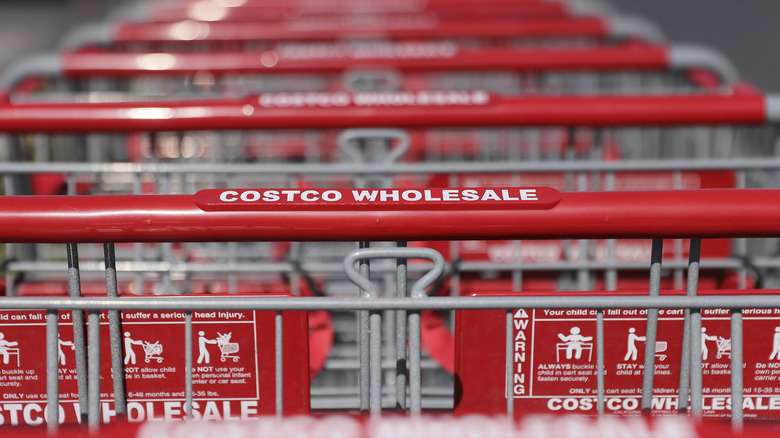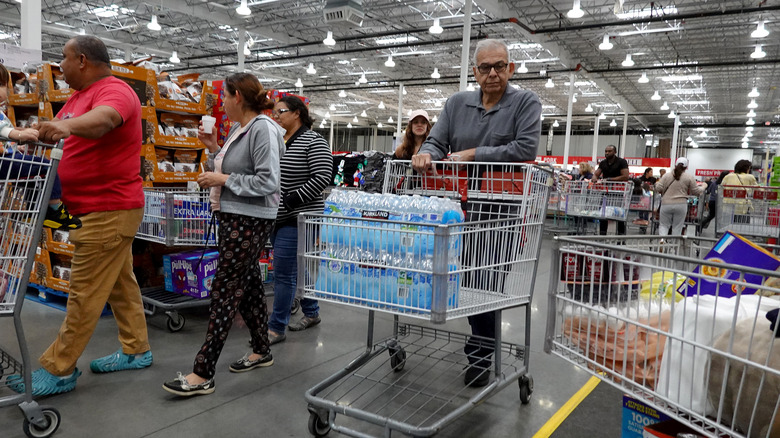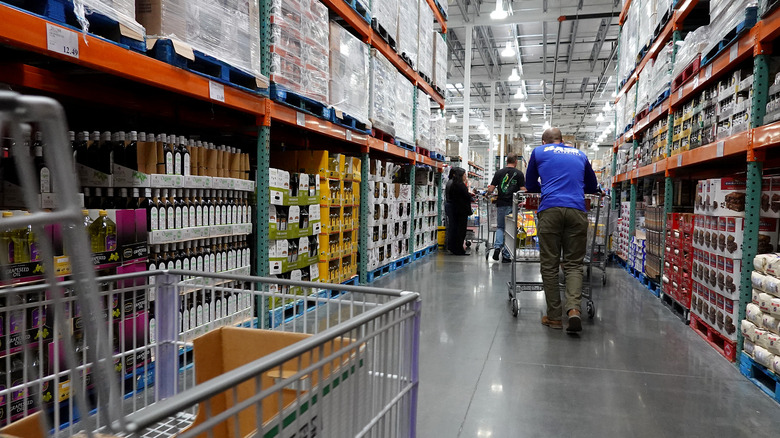How Costco Sends Its Shoppers On Grocery Treasure Hunts
Costco isn't a regular grocery store, it's a cool grocery store. Millions of loyal devotees would agree, and have flocked to the supersized warehouses by the millions since Costco first hit the scene in the early '80s. The list of reasons to love Costco is almost as jumbo as the Costco floorplans themselves: Economical prices, bulk-sized versions of your favorite products, free samples, and of course, the beloved Costco food court items.
But there's more than meets the eye when it comes to Costco and why its unique business approach works — one of which is the very intentional floor plan and footpath it sends shoppers on. Inventory isn't just placed willy-nilly on aisles or where it makes the most logical sense — in fact, Costco's "treasure hunt" design of its store is the result of some smart marketing brains. You might not have noticed you're being sent on a treasure hunt when you walk through the jumbo doors of Costco — you might think you're simply making a grocery run to stock up on staples, household goods, and yeah, maybe grab one of their viral hot dogs.
But make no mistake — you're also embarking on a treasure hunt of the CPG variety. By rotating staples, or "triggers," as Costco calls them, all around the store, it purposely funnels shoppers from corner to corner, knowing they'll add plenty of extra items to their carts as they traverse the store.
Costco's treasure hunt designs keeps customers moving, and adding to cart
You'll get your steps in while purusing a Costco, even if you only went in with the goal of grabbing a few key items. Much like no one ever comes out of a Target with just one thing, Costco ensures with its merchandising design you'll have a trunk full by the time you leave. It does so by sending its customers from corner to corner of the store, specifically, sprinkling household staples like toilet paper, cleaning supplies, and tissues in distinct corners of the acres-wide stores. The more aisles you traverse, the more likely you are to stumble upon a bevvy of goods that certainly weren't on your list, but you suddenly need.
A sense of urgency adds a layer to the hunt too, as Costco rotates out products at an accelerated pace compared to other stores. Shoppers know that if they see something they want, they better snag it — it won't necessarily be on shelves next time.
Another genius element of Costco's overall flow and layout is how upon entering the store, shoppers are given almost a bird's eye view of all the store's sections. This differs from say, an Ikea store, which funnels shoppers through an intentionally maze-like floorplan. While Costco stores are massive — encompassing literal acres — this layout along with its pared-down selection of SKUs (similar to Trader Joe's, which intentionally eliminates the paradox of choice) makes shopping a breeze — albeit a hunt.
They're far from the only store to employ similar tactics
Mega Costco fans may notice that in addition to the overarching treasure hunt philosophy, there's also an entirely separate, more literal "treasure hunt" section of the store. This "hunt" is simply a rotating selection of items marked down or priced at extra value for a limited time. These deals are advertised on online flyers and often placed at the center of stores, greeting incoming shoppers with especially deep savings. While most people flock to Costco for bulk-sized pantry staples, toiletries, and other basics at super-discounted prices — as Costco manages to keep prices low, even as prices skyrocket across the board — there are some surprisingly expensive food and drinks at Costco. The items included in the marked-down treasure hunt tend to be of the latter category — think diamond rings, cuts of steak, bottles of wine, or vacuum cleaners.
And if you're wondering if Costo is the only big box store playing games with its customers — far from it. All grocery retailers employ well-thought-out tactics to keep customers moving and buying. It's why you'll often find key staples you probably always need, like milk, bread, and flour, as far away from each other as possible. The takeaway? Your unique set of preferences when it comes to grocery shopping — where you shop, what time of day, and the specific items you grab — may be your own personal art, but the layout of your neighborhood store is all science.


